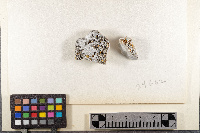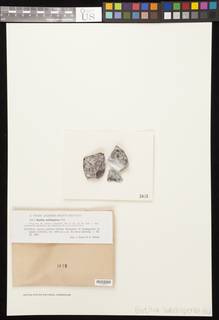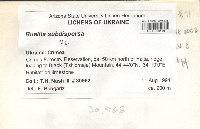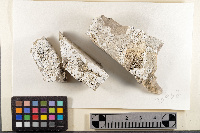
Consortium of Lichen Herbaria
- building a Global Consortium of Bryophytes and Lichens as keystones of cryptobiotic communities -
- Home
- Search
- Images
- Species Checklists
- US States: O-Z >
- US National Parks
- Central America
- South America
- US National Parks
- Southern Subpolar Region
|
|
|
|
Family: Caliciaceae
|
Nash, T.H., Ryan, B.D., Gries, C., Bungartz, F., (eds.) 2007. Lichen Flora of the Greater Sonoran Desert Region. Vol 3. Thallus: crustose, consisting of scattered minute flattened granules or areoles 0.4-2 mm across, sometimes crowded to form wider patches; prothallus: not seen surface: white to yellowish white or brownish gray, esorediate medulla: white, with calcium oxalate (H2SO4+ needle shaped crystals) Apothecia: lecideine, sometimes surrounded by a thalline collar (pseudolecanorine), abundant, < 0.5 in diam., immersed, becoming sessile disc: black, rarely pruinose, with thin, white pruina consisting of calcium oxalate crystals, flat to convex margin: black, thin, at early stages often covered by thallus fragments proper exciple: 12-60 µm thick, lacking secondary metabolites; differentiated into a thin, dark brown outer part with carbonized cells (<5 µm, HNO3-), and a broad, hyaline to pale brown inner part, continuous with the brown, <170 µm thick hypothecium (HNO3-) epihymenium: brown, pigmentation continuous with the outer exciple (HNO3-) hymenium: hyaline, not inspersed with oil droplets, 50-70 µm tall; tips of paraphyses: ±5 µm wide, with distinct apical caps asci: clavate, Bacidia-type, 50-55 x 12-22 µm, 8-spored ascospores: soon brown, 3-septate, ellipsoid, sometimes slightly curved, (12.5-)13-[14.2]-15.4 (-18) x (4.5-)5.8-[6.4]-7.2(-7.5) µm, walls and septa lacking uneven thickenings, proper wall c. 0.2 µm thick, perispore c. 0.45 µm thick, ornamentation: rugulate Pycnidia: not seen Spot tests: thallus and medulla K-, C-, P- fluorescence: UV- iodine reaction: medulla amyloid Secondary metabolites: none detected. Substrate and ecology: epilithic, on calciferous rocks and walls in open situations at elevations ranging from near sea level to 2400 m, at young stages often parasitic on other lichens, e. g. Lecanora spp., Aspicilia spp., and Caloplaca spp. World distribution: Europe, Greenland, North America, and Siberia Sonoran distribution: one locality in Arizona (Gila Co.). Notes: Buellia subdispersa is characterized by its thin, scattered areoles of the thallus and its small, 3-septate spores. The species is similar to Buellia alboatra and B. venusta, but differs from them by having smaller apothecia and spores, and by the appearance of its thallus; and from B. alboatra also by having 3-septate spores. |
Powered by Symbiota

















